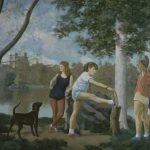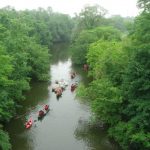Conversations | Ronny Quevedo, Ecuadorian Artist & IAP Mentor
“Try not to hide what you think you are not good at, instead be more proactive about facing what challenges you.”
Ronny Quevedo is a New York-based artist from Ecuador whose work addresses immigration, play, and cultural exchange. He will be part of the Pacha, Llaqta, Wasichay: Indigenous Space, Modern Architecture, New Art show that opens this month at the Whitney Museum of American Art.
His previous project, there is no halftime, took place at the Queens Museum in 2017. The work, with autobiographical insights that include his father’s soccer career as referee and player, interlaced with the playing fields at Flushing Meadows Corona Park as a metaphor for migration.
Quevedo is committed to building community through mentorship and community outreach. He was one of NYFA’s Mentors for the Immigrant Artist Mentoring Program: Social Practice this year.
NYFA: Can you tell us about your work there is no halftime (no hay medio tiempo)?
RONNY QUEVEDO: there is no halftime is a project I did at the Queens Museum when I was given a Jerome Foundation Fellowship for emerging artists. The work revolves around the playing fields at Flushing Meadows Corona Park, where such fields work as a metaphor for migration and the idea of moving from one place to the other. In Corona Park there are soccer fields, volleyball courts, baseball fields, etc. that are being utilized by immigrant communities. They all share this idea of play and movement with their bodies, so I wanted to present something that relates to the environment surrounding the museum. Having the fields in constant movement and fragmented is one of the aspects that influenced my drawings; others are the indoor soccer leagues throughout the city that are played in on weekends. Prior to this, I had developed a series of drawings that were architectural and the Queens Museum exhibition offered me the opportunity to mount them at full scale.
NYFA: What resources have had the largest impact on your career?
RQ: For me, artist residencies have been very important. Residencies in different places have helped me build community not only locally but nationally. Having a place at Project Row Houses to produce work that was directly related to a community had a big impact on my career as well as working with the community I grew up in. It was also helpful to receive large-scale funding from A Blade of Grass to produce Higher Sails, a series that transforms small businesses into social agents by broadcasting community concerns through their ephemera and store signage. This project in the Bronx aimed at creating a platform for residencies to respond to the impact of gentrification through art and design. The Jerome Foundation Fellowship enabled me to have my first museum show. It also provided the experience of working within a museum and with museum professionals.
NYFA: How was your experience participating in our Immigrant Artist Mentoring Program: Social Practice as a mentor?
RQ: I was honored to be part of the discussion. During this program, it was great for me to share my perspective as a New Yorker to immigrant artists. For example, I’m attracted to the visual language of popular culture. I’m influenced by my surroundings and realize how social practice can be a very immediate response to the environment. I grew up here, it was helpful to bring my perspective as a working artist living in New York to artists that haven’t been here so long and to provide some context for when they reach out to their communities.
NYFA: What are some of the strategies that you used as a mentor?
RQ: I was able to give concrete feedback to the artists I was mentoring, showing them my budget and a successful proposal. I would emphasize that what pushes you to the final round during an application (for serious consideration) is coming up with the details of the project. So with my group, we would work on creating very concrete goals, and my feedback would help them refine what they already knew. Everyone is aware of what they need to do, but sometimes they just need some refinement in order to get to the final part of the process.
NYFA: Do you have additional advice for our readers?
RQ: If there is something you need help with, reach out to someone that can help you. We shouldn’t be ashamed of our unfamiliarity with something. For example, I didn’t know how to develop a budget for a very long time. Try not to hide what you think you are not good at, instead be more proactive about facing what challenges you.
Learn more about Ronny Quevedo and see some of his work this month at the Whitney Museum.
This interview is part of the ConEdison Immigrant Artist Program Newsletter #106. Subscribe to this free monthly e-mail for artist’s features, opportunities, and events.
– Interview Conducted by Alicia Ehni, Program Officer at NYFA Learning
Image: no hay medio tiempo / there is no halftime, Ronny Quevedo, 2017 Queens Museum; Photo: Hai Zhang






